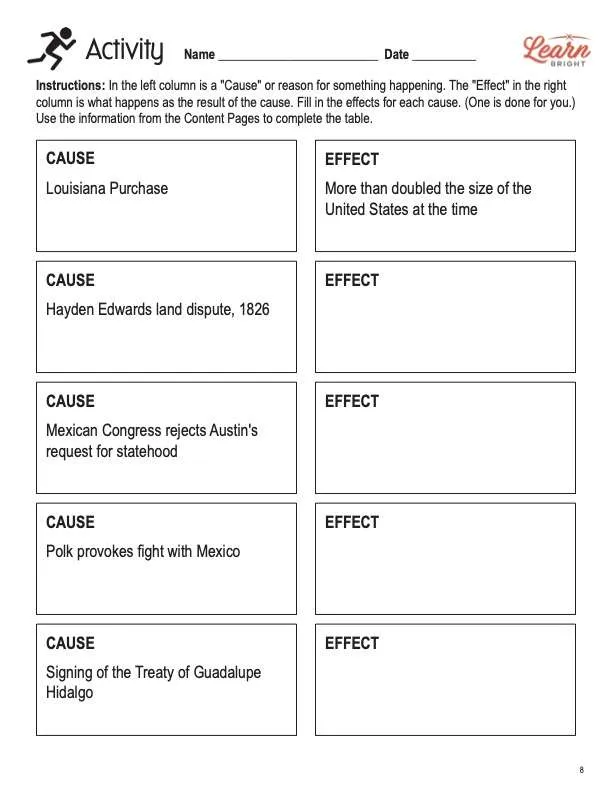Description
What our Mexican-American War lesson plan includes
Lesson Objectives and Overview: Mexican-American War teaches students about how the United States expansion included parts of Mexico. They will identify the leaders in and the significant battles of the war. Students will also explain the impact the war had on future political events in the United States. This lesson is for students in 4th grade, 5th grade, and 6th grade.
Classroom Procedure
Every lesson plan provides you with a classroom procedure page that outlines a step-by-step guide to follow. You do not have to follow the guide exactly. The guide helps you organize the lesson and details when to hand out worksheets. It also lists information in the yellow box that you might find useful. You will find the lesson objectives, state standards, and number of class sessions the lesson should take to complete in this area. In addition, it describes the supplies you will need as well as what and how you need to prepare beforehand. Make sure your students have access to the internet for the practice worksheet.
Options for Lesson
You can check out the “Options for Lesson” section of the classroom procedure page for additional suggestions for ideas and activities to incorporate into the lesson. The Mexican-American War and the Alamo are two of the best- documented events in American history. At the Texas Historical Archives are several letters and documents that explore what many American volunteers were thinking before the battle began. Reading primary source materials is an excellent way to introduce the lesson. Students can also research quotes from significant people in the war, which capture the emotion of the time and provide context for why the battle at the Alamo is so significant in US history. Example from William Travis: “I am determined to sustain myself as long as possible and die like a soldier who never forgets what is due to his honor and that of his country, victory or death.”
Teacher Notes
The teacher notes page provides an extra paragraph of information to help guide the lesson. It mentions that the worksheets are designed to get students to think critically. You can use the blank lines to write down any other ideas or thoughts you have about the topic as you prepare.
MEXICAN-AMERICAN WAR LESSON PLAN CONTENT PAGES
Louisiana Purchase
The Mexican-American War lesson plan includes five content pages. On September 3, 1783, the signing of the Treaty of Paris formally ended the American Revolution. After the ratification of the Constitution, the thirteen colonies became the first thirteen states on March 4, 1789. By 1800, westward expansion convinced Jefferson to make the most significant land purchase in US history—the Louisiana Purchase—from France.
The Louisiana Purchase more than doubled the size of the country and opened the country to westward expansion. However, as the 1840 map shows, much land was yet to be ceded to the United States. Mexico controlled most of what is now Texas, California, Nevada, Utah, New Mexico, Arizona, Colorado, Oklahoma, Kansas, and Wyoming. One of the most exciting events in US history has to do with how the United States gained control over this vast area. It begins with the great state of Texas!
Republic of Texas
Would it surprise you to learn that Texas was not a state but a country at one point in history? In the 1800s, Mexico was a territory of Spain. Around 1820, a US citizen asked permission from Spain to start a ranch in the Texas territory. Few people lived there at the time, and Spain granted the request. His name was Moses Austin, the father of Stephen Austin, who later played an essential role in the founding of Texas. Moses died, leaving the start-up to his son Stephen. Then, in 1821, Mexico became independent of Spain and formed a new country. Austin petitioned the new Mexican government for permission to bring 300 settlers to an area around the Brazos River.
Soon after that, more settlers arrived. Eventually, more US citizens lived in the area than did Mexican citizens. In 1826, there was a land dispute between an American citizen named Hayden Edwards and several local Mexican residents. Mexico sided with the Mexican residents, which angered Edwards, who declared the area no longer subject to Mexican rule. Edwards attempted to form a separate country, Fredonia. (The country’s name originated from the word freedom!) This became known as the Fredonian Rebellion. In support of the locals, Mexico sent troops to squash the rebellion.
Edwards vs. Austin
Edwards sent a request to Stephen Austin for help. But Austin chose to support the Mexican government, not Edwards. Not wanting to tangle with the Mexican military, the colonists mostly left the area, including Edwards. The Mexican government
later allowed them to return, except for Edwards. Many historians believe the Fredonian Rebellion was the first step in the process of gaining Texas from Mexico to join the United States.
By 1830, the influx of Americans alarmed the Mexican government. They took several steps to stem the tide of Americans moving into Mexico. By 1833, the situation between the Mexican government and Americans who had settled in Mexico began to worsen. To calm things, Stephen Austin petitioned the Mexican government for Texas to become a state in the Mexican Federation.
Recall that Austin had refused to help Edwards in the Fredonian Rebellion. When the Mexican Congress rejected Austin’s request for statehood, Austin called on the settlers to declare Texas a state, disregarding the Congress. He was arrested and imprisoned until 1835. The rebellion he led resulted in a stronger response from the Mexican government—military troops.
Santa Anna in the Mexican-American War
In 1834, a new leader in Mexico came into power. Santa Anna was a soldier and the dictator-leader of Mexico. Santa Anna had little tolerance for the American settlers’ demands and rebellion.
In the years before 1835, the Mexican government lent the settlers a cannon to defend themselves from attacks by indigenous native tribes. Then in 1835, the Mexican government asked them to return the gun and sent soldiers to retrieve it. In response to the military, the settlers fired the cannon at the Mexican soldiers, scattering them. (These were the first shots of the Texas Rebellion!) Then, they set up a provisional government and a small military led by Sam Houston in defiance of the Mexican government.
That December, Texas volunteers drove the Mexican soldiers out of San Antonio. Then they set up a base camp at the Alamo. In January of 1836, Santa Anna sent several thousand troops south of the Alamo and demanded that the Americans abandon the fort. As you might expect, Santa Anna would not allow a ragtag bunch of volunteer soldiers to embarrass his professional army. Sam Houston saw that he was severely disadvantaged in the number of soldiers, weapons, and supplies. Houston ordered his men to leave the fort before the Mexican soldiers arrived.
Remember the Alamo!
In an effort not to abandon the cannons and other weaponry at the fort, Colonel Sam Bowie decided to remain. He planned to hold off the Mexican army until Houston could organize and return with more troops. By February, Houston’s troops of about 140 men were facing more than 3,000 well-armed professional Mexican soldiers. The Mexican army pounded the Alamo with cannon and rifle fire for twelve days. On March 1, a small group of Texan volunteers broke the enemy lines and joined the battle with troops inside the Alamo. About 185 soldiers continued the struggle. The next day, the Texas Revolutionary government declared its independence from Mexico.
Finally, on March 6, Santa Anna ordered his men to storm the walls of the Alamo. The Mexican army was met by relentless cannon fire, decimating the first and second waves of the Mexican troops. After about an hour of fighting, the Mexican army was able to breach the walls of the fort. The combat was hand-to-hand, and the numerical advantage of the Mexicans overwhelmed the Texans. Santa Anna had ordered his troops not to take prisoners. The only survivors of the brutal combat were a few women and children. Several hundred of Santa Anna’s men died in the fight as well.
A few weeks later, Sam Houston surprised Santa Anna’s army. As the Texans attacked, they shouted, “Remember the Alamo!” Santa Anna was defeated and captured at the Battle of San Jacinto. The Mexican dictator was defiant, but he was forced to recognize the independence of Texas. Defeated at San Jacinto, Santa Anna was exiled from Mexico to Cuba by the Mexican government, but that would not be the end of his story.
President Polk
Texas had won its independence from Mexico by 1836. But more had to happen to resolve the problems between Mexico and Texas. Initially, Texas asked to be annexed into the United States. The US declined for two reasons. The first was that the issue of slavery had not been settled in the western territories. Northern leaders did not want to add a territory or state that supported slavery. The second reason was that Mexico threatened the United States with military action if they meddled in Mexican affairs. However, by 1844, the US sentiment about annexing Texas started changing.
President Polk strongly believed that western expansion was necessary for the US to continue growing. He wanted to annex Texas into the United States and did so in December of 1845. At first, Polk tried to purchase Texas from Mexico. When that failed, Polk provoked a fight with Mexico by moving troops into a disputed territory.
On April 25, 1846, US soldiers came under attack by Mexico in the disputed territory. Under the command of General Zachary Taylor (a future President of the United States), twelve American soldiers lost their lives. The Mexican cavalry then attacked Fort Texas. With the help of reinforcements, Taylor defeated the cavalry at the Battle of Palo Alto and the Battle of Resaca de la Palma. On May 2, Congress declared war at President Polk’s urging. The United States military advanced into Mexico.
End of the Mexican-American War
The war was not going well for Mexico, and the US was on the verge of victory. So, the Mexican government turned to a soldier from the past. Santa Anna had been living in Cuba after being exiled from Mexico. He was unpopular in the eyes of both Mexico and Texans for his earlier actions in the rebellion. However, Santa Anna convinced President Polk that he would end the war if allowed to return to Mexico. Polk agreed and arranged transportation for Santa Anna to return home.
Santa Anna duped President Polk. Once on Mexican soil, Santa Anna led the Mexican army against the United States. In February of 1847, Santa Anna led his troops in the Battle of Buena Vista and was soundly defeated. Not deterred by his loss, Santa Anna once again took over the government of Mexico within a month of his defeat. By the end of 1847, Santa Anna, weary of battle and unable to command the Mexican government, retired from the presidency.
The US troops continued to press forward, defeating the Mexican army in several battles. By 1848, while skirmishes continued, the war was over. The Treaty of Guadalupe Hidalgo was signed on February 2, 1848, officially ending the war. Mexico received over $18 million from the United States as part of the treaty.
After the War
The Mexican-American War resulted in several firsts. It was the first time the United States fought a war on foreign soil. It was the first time Congress used the War Powers Clause of the US Constitution (Article 1, Section 8) to declare war. Two future presidents fought in the war, Zachary Taylor and Ulysses S. Grant. Robert E. Lee also fought with several future Civil War leaders in the Mexican-American war. Many historians believe the annexation of Texas hastened the Civil War as the expansion of slavery took center stage.
MEXICAN-AMERICAN WAR LESSON PLAN WORKSHEETS
The Mexican-American War lesson plan includes three worksheets: an activity worksheet, a practice worksheet, and a homework assignment. Each one will reinforce students’ comprehension of lesson material in different ways and help them demonstrate when they learned. Use the guidelines on the classroom procedure page to determine when to distribute each worksheet to the class.
MEXICAN-AMERICAN WAR ACTIVITY WORKSHEET
Using the information from the content pages, students will find the causes and effects for different aspects surrounding the war. They will fill in the effects column for each of four causes. (The first pair is complete to help guide them in their responses.) You could have students pair up or work in groups if you like.
WHAT IF…? PRACTICE WORKSHEET
For the practice worksheet, students will have to think critically about what could have happened if Mexico had won the war instead of the US. They will refer to a few questions at the top of the page to help them answer the overall prompt. They will use the blank lines to write what they think the United States would be like if Mexico had defeated the US.
ALAMO HEROES HOMEWORK ASSIGNMENT
The homework assignment lists nine individuals who were heroes during the Battle of the Alamo. Students will choose one of those people and write a short report on them and how they contributed to the history of the Mexican-American war.
Worksheet Answer Keys
The lesson plan document includes answer keys for the practice and homework worksheets. Given the nature of these assignments, student responses will vary and sample responses are given. If you choose to administer the lesson pages to your students via PDF, you will need to save a new file that omits these pages. Otherwise, you can simply print out the applicable pages and keep these as reference for yourself when grading assignments.









